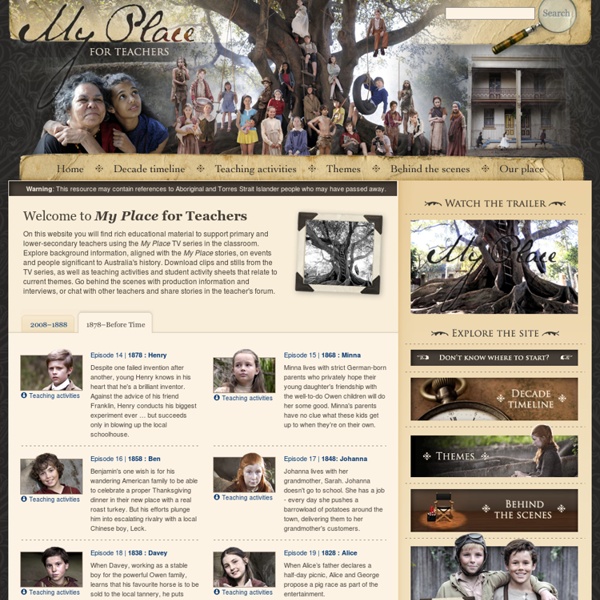



School in the 1940s - History (1,2,3) - ABC Splash - Overview Imagine going to school in the 'olden days' (the 1940s). Find out what morning assembly looked like. Discover the things that children kept in their desks and what they used to do their writing. This clip shows you what school was like in the past as two adults (actors Terry Norris and Carmel Millhouse) remember what they did at school. Duration: 4 mins 28 secs Source : Thinkabout/Talkabout: When We Were Young Learning area: History Primary: Years 1, 2, 3 Before viewing Have you ever asked a grandparent what it was like for them at school? As you view What are the children carrying as they get off the bus? What things are the very young children doing at school? What were the holes for in the old school desks? What sort of pens did the students use? After viewing What things about school in the clip are different today? Talk to an older person about school. Next steps Make a comic strip or cartoon story about a day at school in the past. For teachers About this resource Acknowledgements
First Australians | Sections | Share Our Pride Local people may have a preference for how they are described, for example at a function or event. If you’re not sure of a person’s particular language group and can’t find out, it’s usually okay to simply acknowledge them as Aboriginal or Torres Strait Islander. The easiest way to find out is to ask the person themselves – they will see this as showing respect and they’ll appreciate it. Connection with country is crucial to the wellbeing of Aboriginal and Torres Strait Islander peoples. Usually a ‘Welcome to Country’ will occur at the beginning of any major public meeting. An ‘Acknowledgment of Country’ can be done by any Aboriginal or Torres Strait Islander Australians that are not traditional owners of the country you are meeting on, or by non-Indigenous Australians. Acknowledgements can be done at the beginning of any meeting. Acknowledge the traditional owners/custodians.Pay respect to their Elders past and present.
Visit a restored 19th-century cottage - History Technologies (1,2,3,4) - ABC Splash - Overview Take a trip back in time to discover what some Australian homes looked like in the past. Visit an old miner's cottage that was built long ago. Duration: 1 min 38 secs Source : ABC For the Juniors Learning area: History , Technologies Primary: Years 1, 2, 3, 4 Before viewing Have you ever wondered what it would be like to grow up long before your grandparents were born? As you view What are the cottage walls made from? How was the cooking done in this kitchen, without electricity? How did the people who lived here long ago have a bath? Why is the toilet built away from the cottage? After viewing Pause the video to take a close look at the kitchen and living room. Imagine that you could talk to the people who first lived here. Next steps Keep a list of the things you use in one day that the people who first lived in this cottage did not have. Write or record a story about one day living in this cottage long ago. Transcript For teachers About this resource Acknowledgements Program:
Stradbroke Dreamtime - Reading Australia Publisher's synopsis Stradbroke Dreamtime is a collection of 27 short stories, ideal for reading in class, from acclaimed Aboriginal author Oodgeroo. The stories are traditional Aboriginal tales from Stradbroke Island, the Tambourine Mountains and from the Old and New dreamtime. A bright, beautiful and unique colour illustrated book, paired with Dreamtime tales just for younger readers. Awards Winner 1994 Children's Book Council Book of the Year Award About the author On 3 November 1920, Kathleen Jean Mary Ruska was born on North Stradbroke, an island in Moreton Bay about 30 kilometres east of Brisbane, and the home of the Noonuccal tribe. Kath married Bruce Walker, a waterside worker in Brisbane, and had two sons, Denis and Vivian. In 1964 her first volume of verse and the first by an Australian Aborigine, We Are Going, was published (with the encouragement of Judith Wright and the aid of a Commonwealth Literary Fund) by The jacaranda Press. The eighties also saw further travel.
Culture Victoria What is Eureka? and what happened there? In the early hours of 3 December 1854 a force of police and other troops charged a reinforced camp constructed by miners on the Eureka gold diggings. About 150 diggers were inside the stockade at the time of the attack. In the fighting, 4 soldiers and about 30 other people were killed, and another 120 people taken prisoner. Thirteen people from the stockade were charged with treason – these men were either tried and found not guilty, or charges against them were dropped. Many people think of the Eureka Stockade as a battle between the diggers (rebellious Irish fighting for democracy) and the police and colonial militia (the forces of the British Crown in the Colony). The Hated Gold Licences In 1854, people mining for gold around Victoria had to pay a monthly fee of 30 shillings for the right to mine, regardless of how much gold they found. The Unfair Treatment of Diggers by the Police and Justice System Demands for a Democratic Political System
drs2aboriginaldreaming.pdf